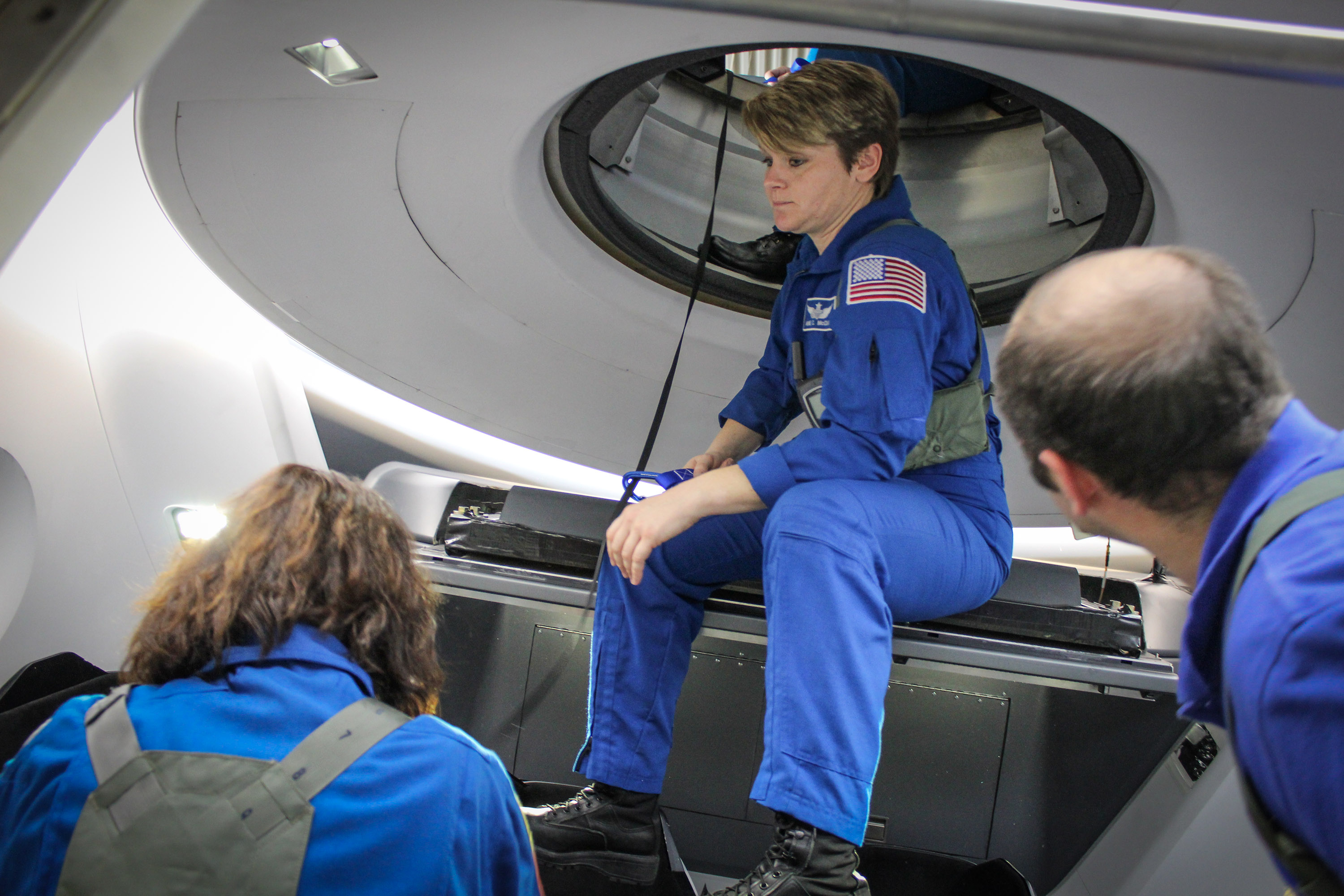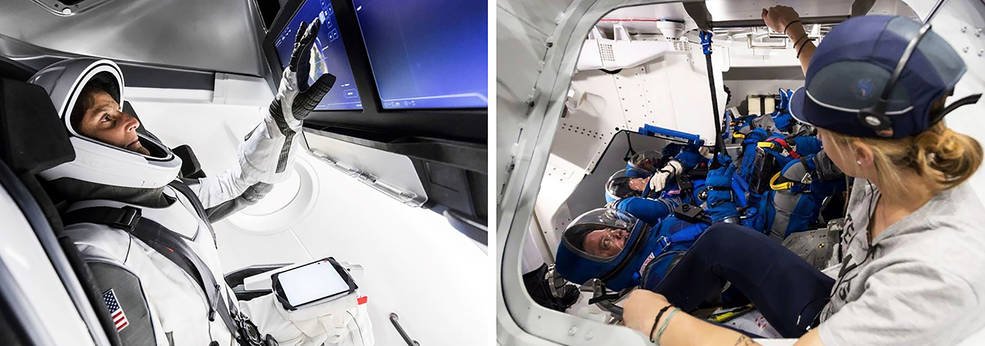Crew Dragon unmanned to ISS: about December 2016
Crew Dragon manned to ISS: about mid 2017
Boeing CST-100 Starliner unmanned to ISS: Q3-Q4 2017
Boeing CST-100 Starliner manned to ISS: Q2-Q3 2018
.jpg/1280px-Crew_Dragon_Pad_Abort_Test_(16816836903).jpg)
Crew Dragon's propulsion uses differential steering; selective throttling of the 8 SuperDraco engines (16,400 lbf thrust each) gives high level directional control. Combined with regular Draco thrusters (100 lbf thrust) the avionics get high powered propulsion and 3-axis control.
The 3D printed SuperDraco's can throttle 20-100% and pulse. 0-100% thrust ramp in 100 milliseconds. Smaller throttle changes can happen faster.
Here's a DragonFly program hover test YouTube video, including a 4x slo-mo. DragonFly will lead to fully propulsive landings, or parachute landings with a propulsive touchdown on land or a sea. Free flying tests will occur over the next few months, culminating in fully propulsive landings.
Crew Dragon manned to ISS: about mid 2017
Boeing CST-100 Starliner unmanned to ISS: Q3-Q4 2017
Boeing CST-100 Starliner manned to ISS: Q2-Q3 2018
.jpg/1280px-Crew_Dragon_Pad_Abort_Test_(16816836903).jpg)
SpaceX Crew Dragon/ Falcon 9
Parachute Testing: Parachutes are vital for the safe return of our astronaut crews. This year, SpaceX will perform thorough testing of the chutes designed for Crew Dragons. Flown inside a transport aircraft, a Crew Dragon test article will be dropped thousands of feet to see how the four main parachutes deploy. Engineers will then review the data and components after landing to ensure that the systems work as expected.
Spacecraft Testing and Training Mock-Ups: An already-built prototype Crew Dragon is being used to assess astronaut entrance, exit and cabin layout. Two high fidelity mock-ups will be used to perform structural and environmental system tests, including evaluations with hatches open and in other configurations to confirm the design's strength.
Crew Dragon Assembly Underway: Three Crew Dragon spacecraft are in different stages of production at SpaceX's headquarters and factory in Hawthorne, California. Two will perform upcoming flight tests to the International Space Station, one without a crew and one with astronauts aboard. The first of these spacecraft will be refurbished after flight for an in-flight abort test that will be conducted from Floridas Space Coast, while the third will fly the operational crew mission to the station by SpaceX.
Falcon 9 Evaluations and Manufacturing: SpaceX will use upgraded Falcon 9 rockets to lift Crew Dragons into space. The upgraded Falcon 9 rocket had its first flight in December 2015, a successful mission that deployed 11 commercial satellites and landed the first-stage back on land. The Falcon 9 is a two-stage rocket that has launched numerous spacecraft into orbit, including cargo-laden Dragons that deliver supplies to the space station.
Launch Pad 39A Completion: SpaceX is on pace to finish extensive modifications of Launch Pad 39A at Kennedy so it can launch Falcon 9 and Falcon Heavy rockets this year. Built for the Apollo/Saturn V moon missions and rebuilt for space shuttle launches, the launch pad at has seen a 300-foot long processing hangar built at the base of the pad, the flame trench remodeled and rails added to move rockets into launch position. Workers will install a new crew access arm and white room so astronauts can board the spacecraft while it stands ready for launch atop a rocket.
Spacesuit Qualification: SpaceX will put its spacesuit through numerous tests and evaluations before it will be put on by astronauts headed into space. Even though astronauts will be inside the spacecraft for a mission, they will depend on the spacesuit to provide them with air and perform other functions.
Environmental Control and Life Support System: Testing is targeted for completion this year for the integrated system that provides crews with breathable, temperature-controlled air throughout their mission and keep all of the spacecrafts systems running smoothly.
Validation of Propulsive Module Land Landing: SpaceX began testing the Crew Dragon propulsive land landing system in McGregor, Texas, late last year. A high-fidelity propulsive module will be used to perform validation testing of the propulsion system in support of land landings. While the company will initially land the Crew Dragon in the water underneath parachutes, the plan is to receive certification of the system for landings on land.
Last Updated: Jan. 20, 2016
Parachute Testing: Parachutes are vital for the safe return of our astronaut crews. This year, SpaceX will perform thorough testing of the chutes designed for Crew Dragons. Flown inside a transport aircraft, a Crew Dragon test article will be dropped thousands of feet to see how the four main parachutes deploy. Engineers will then review the data and components after landing to ensure that the systems work as expected.
Spacecraft Testing and Training Mock-Ups: An already-built prototype Crew Dragon is being used to assess astronaut entrance, exit and cabin layout. Two high fidelity mock-ups will be used to perform structural and environmental system tests, including evaluations with hatches open and in other configurations to confirm the design's strength.
Crew Dragon Assembly Underway: Three Crew Dragon spacecraft are in different stages of production at SpaceX's headquarters and factory in Hawthorne, California. Two will perform upcoming flight tests to the International Space Station, one without a crew and one with astronauts aboard. The first of these spacecraft will be refurbished after flight for an in-flight abort test that will be conducted from Floridas Space Coast, while the third will fly the operational crew mission to the station by SpaceX.
Falcon 9 Evaluations and Manufacturing: SpaceX will use upgraded Falcon 9 rockets to lift Crew Dragons into space. The upgraded Falcon 9 rocket had its first flight in December 2015, a successful mission that deployed 11 commercial satellites and landed the first-stage back on land. The Falcon 9 is a two-stage rocket that has launched numerous spacecraft into orbit, including cargo-laden Dragons that deliver supplies to the space station.
Launch Pad 39A Completion: SpaceX is on pace to finish extensive modifications of Launch Pad 39A at Kennedy so it can launch Falcon 9 and Falcon Heavy rockets this year. Built for the Apollo/Saturn V moon missions and rebuilt for space shuttle launches, the launch pad at has seen a 300-foot long processing hangar built at the base of the pad, the flame trench remodeled and rails added to move rockets into launch position. Workers will install a new crew access arm and white room so astronauts can board the spacecraft while it stands ready for launch atop a rocket.
Spacesuit Qualification: SpaceX will put its spacesuit through numerous tests and evaluations before it will be put on by astronauts headed into space. Even though astronauts will be inside the spacecraft for a mission, they will depend on the spacesuit to provide them with air and perform other functions.
Environmental Control and Life Support System: Testing is targeted for completion this year for the integrated system that provides crews with breathable, temperature-controlled air throughout their mission and keep all of the spacecrafts systems running smoothly.
Validation of Propulsive Module Land Landing: SpaceX began testing the Crew Dragon propulsive land landing system in McGregor, Texas, late last year. A high-fidelity propulsive module will be used to perform validation testing of the propulsion system in support of land landings. While the company will initially land the Crew Dragon in the water underneath parachutes, the plan is to receive certification of the system for landings on land.
Last Updated: Jan. 20, 2016
The 3D printed SuperDraco's can throttle 20-100% and pulse. 0-100% thrust ramp in 100 milliseconds. Smaller throttle changes can happen faster.
Here's a DragonFly program hover test YouTube video, including a 4x slo-mo. DragonFly will lead to fully propulsive landings, or parachute landings with a propulsive touchdown on land or a sea. Free flying tests will occur over the next few months, culminating in fully propulsive landings.









.jpg)



Comment